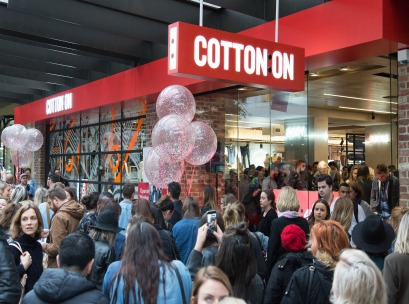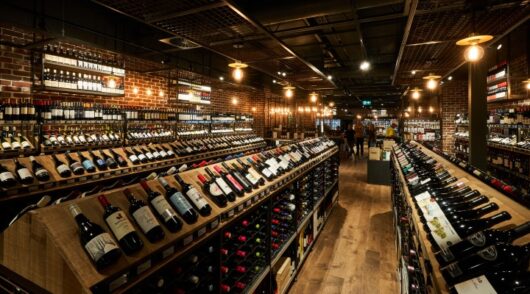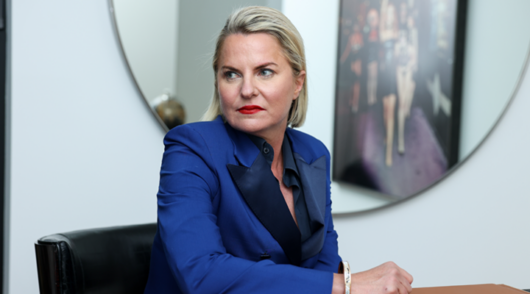 BIO: As CEO of the Cotton On Group, Peter Johnson has overseen the company’s footprint grow from 50 Australian Cotton stores in 2004 to over 1,500 stores and seven brands operating in 19 countries. He previously worked for retailers including Sportsgirl, Jeanswest and Country Road.
BIO: As CEO of the Cotton On Group, Peter Johnson has overseen the company’s footprint grow from 50 Australian Cotton stores in 2004 to over 1,500 stores and seven brands operating in 19 countries. He previously worked for retailers including Sportsgirl, Jeanswest and Country Road.
COMPANY PROFILE: Launched 25 years ago in Geelong, Victoria, the Cotton On Group owns several brands including Cotton On, Cotton on Kids, Cotton on Body, Factorie, Supre, Rubi and Typo. The Group also has a philanthropic arm, the Cotton On Foundation, which has raised $60 million to create 20,000 educational places globally by 2020.
IRW: There is a lot of woe in the media about fashion retailers at the moment. Is it maybe because some haven’t evolved?
PJ: “We describe it as tough because I think we’ve had a pretty good run. So when the run starts to slow down and if you’re not forward projecting the change or getting too carried away and taking your eye off the things a good retailer should keep their eye on, I imagine people can describe it as tough.
But we’ve got to remember the old retail model, which was based on when the industry is growing, grow as much as you can, as fast as you can and add as many stores as you can. It was all about growing in size and scale, continuing to turn it over and grow your footprint – that was because costs were under control or they were depreciating because we were going to lower cost countries and the market as a whole was growing. It was fairly protected. Retail was isolated, you played in your patch and if you did a good job, you were okay. If you didn’t, you had to work to get it back but of course, it was before e-commerce, so those were all factors retailers thought of when they thought ‘growth’.
We were the same, but I guess our difference was we went into markets that could change. We went into America five years ago and Asia eight or nine years ago, so we saw what happens when [those markets] change – the American market had been experiencing what the Australian market has been experiencing for five years. We saw the shift from shopping centres to online, we saw what happened when international brands came and took market share from the local [retailers] and so we’ve already been aware of it. We’ve all had strategies to deal with it. I don’t think there would be a CEO in their seat that wouldn’t be talking about the shifts and the macro changes but the retail principle hasn’t changed.
The principle is you stay really close to your customer, you understand your position in the market, you understand your brand DNA and you adapt and evolve your offer, whether that be offer, product or service experience to suit. Yes, the conditions have changed but 20 years ago, I’m sure CEOs of retailers would have said the same thing. We’ve got pressure from competition, pressure from cost growth, so yes, it’s described as tougher because I think we have had a good run. There are players who are down and there are players that are up, who I suspect are those that are staying agile in their thinking and keeping the customer at the heart of everything they do, then responding and executing their strategies.”
 IRW: Are some retailers trying to be something that they’re not?
IRW: Are some retailers trying to be something that they’re not?
PJ: “I’ve been in this business for 13 years and one of the first things that struck me when I joined Cotton On as a smaller business with 50 stores, was it was very determined to create its own identity and it didn’t analyse other businesses the way I was used to with my past job. The Monday morning meeting wasn’t around what everyone else is doing, it was about our sales, what did we do, did the changes that we had made work or not? So if your question is, whether I think retailers or businesses in general get too outward focused, then I think the answer is probably yes. And I think if you’re not clear about your position or your strategy, then you look for explanations.
But I’ve found over and over again, the answer is generally inside and I actually think we get the strategies pretty right. We mostly read the play or situation and see the shifts – none of that is rocket science. Most of us have the information to work that out but the difference is the ability to execute and stay on track with your strategy. We’re guilty of it as well and I’m not saying we’re perfect, but whenever we have a challenging period, nine times out of 10, we analyse it and just didn’t execute the strategy that well and often it’s because of distraction. You’re focused on other factors, a diluted focus in trying to do too much and sometimes it’s been in our case that we’re growing so quickly that we haven’t slowed down enough to get a few things right.”
IRW: Obviously Australia would be your biggest market compared with emerging or a new markets. Do you tailor towards the demographic when expanding or keep hold of the values back home and implement them in the new market?
PJ: “Our brand is positioned as a casual lifestyle brand and what’s been happening over the last five years is the emergence of health and wellbeing plus more of a casual lifestyle. As a population, we are challenging corporate and rigid thinking, so focusing on health and wellbeing has played into our hands beautifully.
We are a lifestyle brand and what we’ve found is that resonates around the world. Australia lives that and we’re finding that it resonates in the countries where we’ve been successful. We define our model as a push model, we export casual lifestyle apparel to the world and then we adjust it accordingly. So we start with that position and then read the subtle differences.
We would say there’s anywhere up to a 20 per cent difference and the difference might be the cut [apparel shape] in Asia, because it’s a different cut in Brazil again and a slightly different aesthetic in America. In South Africa, there might be colour palette differences, there are some styles that work there, but don’t work here, so there can be anywhere from five per cent to 20 per cent variation on the push model that we have.
Over the last five years, we’ve built what we call ‘regional hubs’ in Los Angeles in the US, Johannesburg in South Africa, Singapore in Asia, Auckland in New Zealand and Sao Paulo in Brazil. We’re building that local knowledge with the model being that we protect the brand. The design will be exported but the local business will then execute our brand to our standards and what they feed back to us is what works and what doesn’t, which is where those little nuances and tweaks come from. To some degree, we’ve localised while remaining a global model, taking the insight from the local team to apply to our overall terrain.
Often the little trends that appear in one market will pop up in another shortly after anyway, it’s a pretty quick cycle these days. When a trend takes off in one country, it doesn’t take long to be adopted by another. Our head office has trend forecasters, designers and developers that are all searching the globe. We’ve also got these feeder systems that come and give us insight as to what’s going on in each of these markets constantly. It’s no longer a trip around the world to work that stuff out, we’re getting it every day, every week. Each week, we’ll have a trade meeting with a market to get their insights and all that goes into the melting pot to work out how do we adapt and evolve our range.”
 IRW: We hear a lot about people using data to improve the CX on a daily basis. I’m curious to know if it’s more about using data and technology to refine supply chains and logistics or the less sexy stuff. Is that perhaps where the digitisation or the use of tech to help a retailer in today’s market is?
IRW: We hear a lot about people using data to improve the CX on a daily basis. I’m curious to know if it’s more about using data and technology to refine supply chains and logistics or the less sexy stuff. Is that perhaps where the digitisation or the use of tech to help a retailer in today’s market is?
PJ: “My view is it’s absolutely becoming more important to understand your customer and to cater to his or her individual needs.
Taking technology out, the Cotton On Group was built on that localisation model. So even when we were just in Australia, we had a slightly different assortment in Queensland compared to Sydney, Melbourne and Perth. That 80-20 rule applied even within Australia. At a style and store level, we adjusted the range – we had more summer in far north Queensland, the obvious stuff – but even before technology was at play, the Cotton On Group was built on getting the details right.
You have to make sure you know exactly what your customer wants and that meant analysing sales to work out what those shifts were, the timing and differences and so on. So while it [technology] was always at play there, it wasn’t driving the thinking. The thinking was that we need to make sure that we’re so close to our customer that we get the right assortment, so my view is technology today is helping us support that thinking and the decision making, which is becoming faster and there are more sources of it.
It used to just be our sales data, it’s now our e-commerce data, we can now judge based on what people are searching for. It is still in the sales data, but you can get more detail from the sales data and more detail from the analytics that goes on in e-commerce. But fundamentally, data is there to support your thinking around delivering what the customer wants and doing it faster.
I hope that’s always the case because I love retail and the fact that it’s a human industry – you touch it, it’s something real and tangible and there’s a little bit of the wild west about it. There’s science but then there’s lots of creative genius and thinking in retail and it works best when you have a mix of both and don’t let one completely override the other.
But technology is certainly increasing at a rapid pace around the information that we do have and act on. I think we get lost – it’s one of those areas where you have to be really clear on what your focus is because there’s no shortage of data. It’s understanding what’s important, what do you need to run the business and what are your capabilities.
Then you get to supply chain. There is a real competitive advantage when you can leverage the supply chain. And that does rely heavily on information and data flow and being able to pre-forecast fabric groups and production space, then getting the right quantification so that you’re delivering stock but not holding too much.
Cost is no longer a competitive advantage because there’s nowhere cheaper to go. I think most companies today will be looking for that margin improvement through a reduction in their markdowns as opposed to an increase in their margin at buying price. To reduce your business markdown, the best way to do that is to never have the wrong stuff in your business.
And that’s where I think the real competitive advantages comes from today and in retail, you have to pretty much be elite at that now, let alone the next few years. I think it will then shift to more customer insight and that will be where businesses can form another competitive advantage through an amazing supply chain that’s responsive, agile and brings product to market really quickly. Then it will be how we really get the customer insight to predict that, rather than respond to it. I’d say today we’re still responding to it.”
IRW: What is it that keeps customers still visiting stores rather than order online?
PJ: At Cotton On, between five and 10 per cent of our sales are online. So the first part of the answer to your question is 90-95 per cent of people are still buying in-store. The reality is they are both online and in-store and that will continue. We will absolutely continue growing our e-commerce business. We’ve had 20 per cent year-on-year growth for the last five years and continue to plan for that or more.
We’ve had stable growth in physical stores, but we’ve gone away from ‘more is better’ from a store point of view. We’ve shifted our focus from ‘let’s grow our store footprint’ to ‘let’s grow our business’ and we’ll grow our business through more productive stores rather than lots of stores. But that’s retail and understanding what your customer wants, if they’re doing both, you have to do both.
I think most people are working out e-comm is a really convenient and wonderful tool and can be a great experience. So if you want to continue to have shopping centres and strips, you’ve got to offer an equally good or greater experience. I think as a whole, the industry was a bit slow to reinvest into those environments. Shopping centres are today reinvesting in their food courts and entertainment offer – not just adding more shops because that’s competing head to head without a competitive advantage.”
 IRW: In your time at the Cotton On Group, how would you describe the evolution of the store design over time?
IRW: In your time at the Cotton On Group, how would you describe the evolution of the store design over time?
PJ: “I think ten years ago, it was about having the right product at the right price and in our position. A 200sqm store turned over a million dollars and didn’t really have space, so how do you add value to the experience in-store? When we went overseas and started trading against some of the bigger players in the world, in some of the largest markets, we rocked up with our 200sqm store model against some of our competitors, who were around 1,500-2,000 sqm and we were dwarfed.
And while that worked and we were successful because we were new and fresh, we learned quickly that it didn’t have an impact. We wouldn’t get on everyone’s shopping list. We didn’t want to be the little niche guy next to the big guy.
So we worked on that format over a number of years around expanding the size of the store and then bringing in an experience that elevated the brand. For a number of years, it became more about building credibility around the brand, a brand people could trust and feel confident in.
We always say product is king, as every retailer should, because you have to have great product and we constantly focus on that. We’ll focus on our point of difference with our product – you can’t just make the same stuff as everyone else. You can’t trick it up and put it in as a much better experience, then expect to get more from it. The reality is that it’s getting harder to distinguish your product through quality or price.
Our strategy is to create a point of difference around our brand and our store experience. So we invested in our stores and created bigger stores and better experiences. We tried to break up the stores more so you knew where you were shopping – it wasn’t just a mass of racks and more products.”
IRW: When it comes to personalisation, does the Cotton On Group need to really be cognisant when it comes to personalising the experience? Or does its value proposition, which is a little bit different to other retailers, need to focus less than others?
PJ: “The answer is yes. It’s a trend. If you looked around here, you’d probably find someone with a phone case with their initials on it. My bag’s got my initials on it. There is that push back, wanting to feel individual and anti-corporate. So I think personalisation is real.
For example, we have trialled a few personalisation products and they’ve been unbelievably successful. Just last week, Cotton On Kids sold 1,000 personalised sleeping bags in four hours. So I think it’s real. Typo’s another great vehicle for personalisation around our water bottles or diaries – it’s really easy to execute and makes the difference between paying a couple of dollars for a standard water bottle and five for one that’s personalised.
Again that’s how you fight margin pressures, by adding value to the product and separating it from the pack. If it’s a trend in retail, you have to be part of it. We’ve always been a business that’s tried to not necessarily be first, but the fastest to adopt. We don’t pretend to always get it right, but we want to make sure we get it right pretty quickly.”
IRW: Dare I ask, are there any new countries on the cards?
PJ: “No, not at the moment. If you look at our portfolio, we’re up to 19 countries. Australia is the largest at about 50 per cent of our business. New Zealand, America and South Africa all fall into 10-15 per cent of our business then the rest of the countries form anywhere between one and five per cent. So our logic is we’ve got plenty of regions and places we can grow out.”
IRW: Any major targets moving forward?
PJ: “No, as I said, we’ve shifted our focus on store numbers to healthy growth with a view that we continue to grow and grow profitably. We’ve gone away from setting those deliberate growth milestones. To some degree, they were a mechanism that gave everyone a target. So when the industry is growing at five and six per cent and we were growing our stores to get to 500, to 1000, I think they were good metrics in that environment.
Today, I think the right metrics are quality of growth and retaining your customers and building their loyalty. So we’ve shifted the way that we set our goals to see that behaviour coming through, about creating a genuine relationship with our customer, rather than being a hungry hippo. We are a private company and never set public goals. Even internally, our goals are far less about the top line and store number growth and far more about how connected our customer is.”





